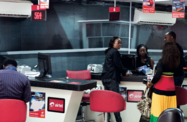Nigeria’s access to the internet has long been hampered by a shortage of bandwidth, but a trio of new undersea cables is set to greatly improve the country’s connectivity. The first of these went active in July, promising cheaper and more reliable access for the Nigerian market.
Known as MainOne, the 7000-km fibre optic cable runs from Portugal from Nigeria and Ghana with connections to Morocco, the Canary Islands, Senegal and the Côte d’Ivoire. “This is an important step toward lower costs of international communication and significant expansion of internet access,” Funke Opeke, the chief officer of the Mauritius-based MainOne Cable Company, said at the commercial launch of the cable on July 21. Financed in part by the Africa Finance Corporation, MainOne breaks ground as the first successful private sector-led initiative to increase bandwidth access in Nigeria.
According to local press reports, the Nigeria Communications Commissions reportedly cut down the price for MainOne’s licence from $50m to $25m in order to have the capacity installed as soon as possible. The first phase of the project was priced at $240m, and the cable will ultimately be extended to South Africa, giving West Africa unprecedented access to global broadband networks. Three telecoms providers (market leader MTN, Etisalat and Starcomms) have already subscribed to MainOne and are rolling out services.
At 1.92 TB/s, MainOne has 10 times the capacity of the current South Atlantic 3/West Africa Submarine Cable (SAT-3), the only other cable currently connecting Nigeria to Europe. State-run Nigerian Telecommunications has an 8.39% stake in SAT-3, making it one of the main investors in the ownership consortium, along with France Telecom and AT&T. Many Nigerians use satellite access, as SAT-3 has been prone to service interruptions, including several weeks in July 2009 when Nigeria lost 70% of its internet bandwidth access.
According to the Ministry of Information and Communication, there were 74.5m telecoms subscribers in Nigeria in 2009. However, the vast majority of these are mobile customers, with internet access much less common, due predominantly to SAT-3’s high prices for bandwidth. At $4500 to $12,000 per month, a 1-MB/s connection costs up to 50 times for ISPs more in African countries served by SAT-3 than in the US.
Following MainOne two more cables are scheduled for launch in the near future, which will help to further drive down prices for Nigerian Internet users. One of these, Glo1, is the work of Nigerian mobile provider Globacom and will run from the UK to Lagos with 640 GB/s capacity. After multiple delays due to problems securing governmental permits, the cable is scheduled to be operational by August.
“[Glo1] will provide high-speed, high-quality bandwidth and connect West Africa to the rest of the world,” Mohammed Jameel, the group COO of Globacom, told OBG in 2009. “It could serve a wide variety of other purposes as well. For example, if a Nigerian bank wants to build a disaster recovery centre in London, the cable would help make this possible.”
With a capacity of 3.84 TB/s, the third cable is expected to have the biggest impact on the Nigerian market. The West Africa Cable System (WACS) is a $600m undertaking by a consortium of international telecoms operators, including MTN, and will stretch 14,000 km from the UK to South Africa with stops in 12 African countries along the way. The cable is expected to be ready in 2011.
Ongoing electricity problems, however, threaten to dilute the gains of expanded bandwidth capacity. At under 4000 MW, Nigeria’s power output remains far below the level of demand - estimated at around 25,000 MW - which poses a formidable barrier to economic development. The new cables will certainly improve the situation for internet users, but other infrastructure improvements will also be needed if the country is to fully capitalise on the investment.

